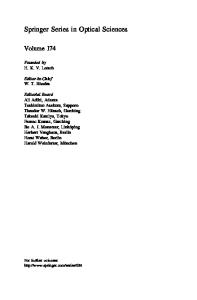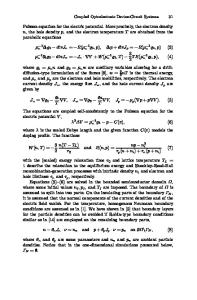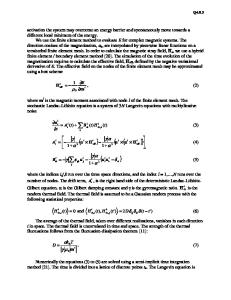Numerical Simulation of Thermal Effects in Nonlinear Optical Materials
- PDF / 615,866 Bytes
- 17 Pages / 414.72 x 648 pts Page_size
- 111 Downloads / 380 Views
Edward H. Wahl Stanford University Stanford, California
Joseph F. Roach Science & Technology Dir. US Army Natick RD&E Ctr. Natick, Massachusetts
ABSTRACT A numerical simulation of the nonlinear optical and thermal response of a material is described. The code is divided into preprocessor, simulation and postprocessing functions. The simulation function is a transient, three dimensional, finite difference algorithm which describes the thermal response and the optical phase change that occurs due to 3rd order nonlinearity and thermal effects. Irradiance changes due to linear and nonlinear absorption mechanisms are included in the code. In the postprocessing function a Gaussian beam decomposition technique is used to calculate the irradiance and transmitted power at a far field location and the temperature time response of the material. Examples of using the code to simulate Z-scan experiments are presented and compared to those reported in the literature. Results are presented that demonstrate that the code can be used as a tool to investigate using thermal transport mechanisms to modify the nonlinear optical response of the material. Limitations of the code are discussed. INTRODUCTION
Thermally induced nonlinear optical behavior of materials have been shown to be significant in many situations, even for nanosecond pulse width radiation, [1-3]1. These thermal effects are predominant in materials with a high absorption coefficient. The development of a numerical simulation technique of the combined thermal and optical response of a material to laser radiation is presented. The thermal response of the material is described as a three dimensional, transient system. The incident laser radiation is assumed to be a Gaussian beam. This simulation technique can be used to separate thermal effects from other nonlinear optical mechanisms and to predict the onset of thermal damage. Both the thermal response as well as the phase distortion caused by the nonlinear optical mechanisms and thermally induced changes in the index of refraction are calculated. The code can also be used to analyze the effects of altering the material's properties on the nonlinear optical behavior. For example, the effect on the nonlinear optical behavior of seeding a material to increase its absorption coefficient can be investigated.
1 Numbers in brackets refer to similarly numbered references in the bibliography. 15
Mat. Res. Soc. Symp. Proc. Vol. 374 01995 Materials Research Society
The described code should be viewed as a platform which can be further developed to include different nonlinear optical mechanisms. It is demonstrated that it is a viable tool that can be used to investigate the nonlinear optical behavior of materials. The present version of the code is restricted to thin samples of the nonlinear material and to laser pulse widths that are on the order of nanoseconds. DEVELOPMENT This code combines a transient finite difference thermal response model with an electromagnetic wave model and a refraction model. The present analysis in
Data Loading...









